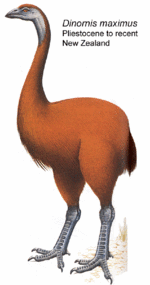Moa
|
|
| Moa Conservation status: Extinct (c. 1500) | ||||||||||||
|---|---|---|---|---|---|---|---|---|---|---|---|---|
 | ||||||||||||
| Scientific classification | ||||||||||||
| ||||||||||||
| Genera | ||||||||||||
|
Anomalopteryx |
The moa were giant flightless birds of New Zealand. Ten species are known, of varying sizes, with the largest species, the Giant Moa (Dinornis robustus and Dinornis novaezelandiae), reaching about three metres (ten feet) in height and about 250 kilograms (550 pounds) in mass. They were the dominant herbivores in the forest ecosystem.
Moa became extinct around the year 1500. This is thought to be due to hunting and land clearance after humans arrived in the islands although another school of thought suggests that numbers were declining before the impact of humans. Before the arrival of humans, some moa were hunted by Harpagornis, the world's largest eagle which is also now extinct. The kiwi are regarded as moderately close relatives of the Moa.
Although the indigenous Māori told European settlers tales about the huge birds which they called Moa, which had once roamed the flats and valleys, the widespread physical evidence that they had actually existed was never closely examined by early European settlers.
|
Missing image Dinornis1387.jpg Owen with moa skeleton |
In 1839, John W. Harris, a Poverty Bay flax trader who was a natural history enthusiast, was given a piece of unusual bone by a Māori who had found it in a river bank. He showed the 15cm fragment of bone to his uncle, John Rule, a Sydney surgeon, who sent it to Richard Owen who at that time was working at the Hunterian Museum at the Royal College of Surgeons in London. Owen became a noted biologist, anatomist and paleontologist at the British Museum.
Owen puzzled over the fragment for almost four years. He established it was part of the femur of a big animal, but it was uncharacteristically light and honeycombed.
Owen announced to a skeptical scientific community and the world that it was from a giant extinct bird like an ostrich, and named it "Dinornis". His deduction was ridiculed in some quarters but was proved correct with the subsequent discoveries of considerable quantities of moa bones throughout the land, sufficient to construct skeletons of the birds.
Although dozens of species were described in the late 19th and early 20th century, many were based on partial skeletons and turned out to be synonyms. More recent research, based on DNA recovered from museum collections, suggest that there were only ten species, including two giant moa. The giant moa seems to have had sexual dimorphism, with females being much larger than males; so much bigger that they were formerly classified as separate species.
In July 2004, the Natural History Museum in London placed on display the moa bone fragment Owen had first examined, to celebrate 200 years since his birth, and in memory of Owen as founder of the museum.
Though there is no reasonable doubt that the Moa is extinct, there has been occasional speculation that some may still exist in deepest south-westland, a rugged wilderness in the South Island. Cryptozoologists and others reputedly continue to search for them, but none have ever been found, and some might regard such efforts as pseudoscience.
Freaneymoa.jpg
In January 1993, on the West Coast, three people, Paddy Freaney, Sam Waby and Rochelle Rafferty, claimed to have seen a large bird they suspect was a Moa. They took a picture of it while it ran away, displaying a blurry photograph showing a medium pink-brown horizontal body, a tall erect neck, and a head that may be looking towards the camera. After photo analysis was done, the picture was confirmed as real, but it was said that the subject could be either a large bird or a red deer. It was thought to have actually been an emu, but in New Zealand it only existed in a fenced breeding area whose owner, Lady Isaac, dismissed the possibility that any of her birds could have run away. The Freaney incident is looked upon as no more than a hoax, especially from the fact that Freaney is the owner of the local Bealey Hotel: according to most, he would obviously make up this story to attract clients, and he still takes advantage of it today. Yet Freaney insists it was a Moa he saw and photographed.
Moa expert Beverley McCulloch from the Canterbury museum says that Moas still living deep in the wild is extremely unlikely, since they would be giant birds in a region that is often visited by hunters and hikers. By way of counter-argument Paddy Freaney mentions the case of the takahe which was thought to be extinct but found after half a century. He believes something similar could happen to the Moa. Most experts would support the former view however.
Still, in February 1993, two hikers, Bruce Spittle and his son Malcolm, found in a mountain hut's guestbook the following message: "We have been very surprised to have seen two moas in Harper valley, because we believed they were extinct" signed by Franz Christianssen and Hulga Umbreit in 9 May, 1992.
See also
External links
- New Zealand Extinct Birds List (http://www.kcc.org.nz/birds/extinct/list.asp)
- Moa Pages (http://www.duke.edu/~mrd6/moa)da:Moa
de:Moa es:Moa fr:Moa it:Dromornithidae nl:Moa ja:モア pl:Moa pt:Moa wa:Mowa
